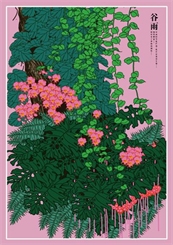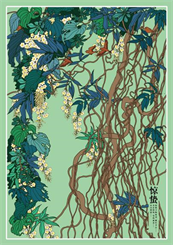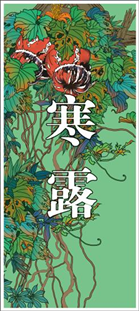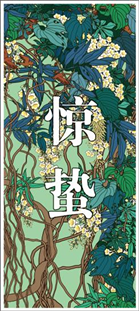Combination of Chinese Painting Creation Method and Illustration Design ()

1. Introduction
1.1. Background and Significance of Topic Selection
As a long-established Chinese culture, Chinese painting is well-known. Not only Chinese people, but even foreigners learn Chinese painting a lot. As China’s long-standing culture, it is a way of illustration design that is worth exploring deeply [1] . Chinese painting is influenced by traditional Chinese culture. Under the background of thousands of years of development history, the creative methods contained in it can be said to be extensive and profound, with a long history, and it is worth learning and carrying forward its excellent connotation [2] .
In the design profession, illustration belongs to the propaganda category and is suitable for promotion. In graphic design, illustration can be well combined with the creation method of Chinese painting. Therefore, I choose “The Combination of Chinese painting Creation Method and Illustration Design” as the topic. The combination of Chinese painting creation method and illustration design can not only innovate the design concept, and enhance the artistry of illustration, but also expand the application field of design. Let the illustration design retain Chinese characteristics while maintaining the vitality of innovation [3] .
1.2. Status Analysis and Summary
For the illustration industry, the current domestic market is lacking in terms of demand and development. Compared with the illustration market in foreign countries, it is far from enough [4] . At present, the development time of domestic illustration is short, and the system is not very perfect [5] . For example, China publishes nearly 50,000 kinds of children’s books every year, and the total output value of the picture book market will exceed 45 billion Yuan, among which the total number of local picture books will exceed 30,000, which requires a large number of illustration creation. Relatively speaking, illustration designers often fight price wars and have insufficient time to think about creativity. This requires the benign progress and elimination of the market, step by step toward standardization [6] . Overall, the illustration is developing in a good direction and I believe it will get better and better.
1.3. Overview of Domestic and Foreign Development
Illustration design is a form of artistic expression, also subject to market demand. Judging from the development status at home and abroad, it can be clearly seen that the western illustration art was formed earlier and has a higher degree of acceptance by the public [7] . Relatively speaking, foreign markets are undoubtedly more perfect and standardized. However, with the continuous development of our country’s economy, the country’s emphasis on and protection of creative intellectual property rights has allowed us to make great progress in the illustration market in recent years. Only by starting from the essence of our country’s culture can we develop an independent path based on evidence [8] . The road, goes to the highest point of illustration art, so that talents will continue to appear and the market will prosper [8] .
2. Analysis of Drawing Methods Using Meticulous Brushwork in Illustration
One of the painting techniques in Chinese painting, “line drawing”, is a relatively down-to-earth painting. It is the main modeling means of Chinese painting. Its characteristics are concise and clear, and can describe various phenomena. In the design of this illustration, the technique of hook line creation used is similar to that of line drawing. But this time, the hook line is subtracted from the line drawing technique, so that it meets the aesthetic needs of modern people, without losing the essence of tradition, and conforms to the overall effect.
In illustration design using Chinese painting creation methods, there are countless elements that can be used. For example: chrysanthemums, peonies, thorns, grasshoppers, lobsters, bunnies, sparrows, orchids, plum blossoms, lotus flowers, winter jasmine, lotus leaves, various strange-shaped leaves, sunflowers…, etc. In the process of creation, I always use the “outline drawing method” in Chinese painting to process the outline of objects. First: The processing of strokes will make objects distinct, enhance the layering of the picture, and give people a strong visual impact. Second: The stroke processing can carefully describe the object, and the overall picture is more delicate and full. Third: The processing of strokes echoes the theme of the thesis, and highlights the traditional Chinese atmosphere, which makes the atmosphere of illustration posters more intense. Fourth: There are mostly plants and leaves in the picture, and the treatment of strokes can properly deal with the leaf stems, which is just in line with the creative purpose and expressed with flat painting, which makes the whole series of illustrations have a strong atmosphere and a clear theme.
3. Design Analysis of Chinese Painting Creation Methods in Illustrations
3.1. The Use of Chinese Painting Composition Analysis in Illustration Design
First of all, there is no intuitive connection between Chinese painting elements and illustrations. Even if we create traditional Chinese illustrations, we cannot simply superimpose them. We should first understand the characteristics of the two, and find the most suitable connection point between the two for creation. Chinese painting is a witness in the history of Chinese art, and it is also one of the most brilliant types of painting in the world today. It is art and history. The core of illustration design and creation is the combination of the simplest flat painting technique with the elements of Chinese painting. The focus is on the artistic conception of Chinese painting, which is its soul. The connection between Chinese painting creation methods and illustration design is to a certain extent also a collision between tradition and modernity, ancient and novelty, and it is a historical dialogue.
The composition form of modern illustration design emphasizes the principle of human aesthetics, simple and concise. The illustration design should use the composition method of Chinese painting to express. The composition of Chinese paintings is often called composition. Under the premise of conforming to the basic layout and arrangement, Chinese paintings pay more attention to the need to create artistic conception. The ancients often used it: one must first sharpen the meaning, and then follow the rules. The illustration design this time focuses on the use of the artistic conception in Chinese painting, such as arranging the elements of Chinese painting reasonably in the picture and leaving blank space in the composition to reflect the artistic conception.
In the process of combining the creation method of Chinese painting with illustration design, the creation of illustration design uses the composition of Chinese painting “a lot of blank space”. First: Use a simple style to make the center of the picture compact. Second: The picture effect of Chinese painting is that there are not many objects in the painting, but it highlights the theme, making the picture have a visual center. The author also adopts this point when creating illustrations and designs. Instead of flooding the picture with a large number of objects, a small number of objects and backgrounds are used to create a well-proportioned “silhouette beauty” in the composition. Third: In terms of the overall layout of the screen, I used a combination of large borders and small inner borders. This layout can better reflect the large and small screens, one far and one near, and enhance the contrast of the screen. Moreover, the combination of the large frame and the inner small frame makes it easier for people to introduce the visual center, which enhances the picture effect and highlights the theme. Fourth: Chinese painting pays attention to both rigidity and softness, there is a circle in a square, and a square in a circle. Therefore, it is just in line with the effect of the picture I created. The flowers, insects, birds and animals in the picture represent all things in nature, symbolize harmony, and also represent circle. The screen adopts a combination of large frame and inner small frame, which represents squareness. The overall feeling is deeply understood from the cultural aspect, that is, “hardness and softness go hand in hand, there is circle in the square, and square in the circle”.
3.2. Analysis of the Use of Chinese Painting Colors in Illustration Design
Compared with western painting, there are not so many so-called coloring principles and steps in Chinese painting. Chinese painting pays attention to the use of color to shape, and color is inseparable, trying to achieve a three-dimensional effect. The ancient people’s painting creation most emphasized a state of adding color according to the category, and painting creation is not a simple type of printed matter. It is a change of activity, which changes with emotion, and must not be bound by experience and methods. Therefore, the color principle of Chinese painting used in this illustration design is to add color according to the category, without paying too much attention to techniques. Try to do it as much as possible, the color changes with the change of the work, the color not only expresses the space, but also expresses the time.
When it comes to Chinese painting, we are all familiar with it. When it comes to Chinese painting, we will be full of praise. The use of color in Chinese painting is amazing. Its unified tone expresses unified emotion and has a complete picture effect. The author also used this point in the creation of illustration design. When matching colors, the author did not use bright red and green like the European painting style…and so on. Some bright, high-purity colors, although this is more prominent. The picture stimulates people’s eyes and makes people excited. Relatively speaking, the author uses some gentle, quiet, elegant, and simple colors. Although these colors are not so conspicuous, exciting, and gorgeous, they feel a harmonious, warm, and comfortable feeling overall, which is refreshing, as if entering another realm.
4. Application of Chinese Painting Creation Method in Illustration Design
The combination of Chinese painting and illustration design can innovate design concepts and enrich design elements and styles. This paper uses simple lines, bright color collocation, and scientific composition to show the illustration scenes in the 24 solar terms, which is a tentative and innovative design of Chinese style illustration. Picture 1 and Picture 2 show the artworks personally designed by the author.



Picture 1. The author’s self-drawing-illustration (cold dew, grain rain, Jingzhe).


Picture 2. The author’s own drawing―bookmark.
5. Conclusion
Chinese painting culture is extensive and profound, and it is an indispensable and important part of cultures all over the world. As a new type of cultural carrier, illustration design is of great significance for carrying forward Chinese traditional culture and revitalizing cultural prosperity. The combination of Chinese painting creation method and illustration design is another interpretation of traditional culture, and it is also another reflection on modernity and tradition. In China, where the modern economy is developing rapidly, how Chinese culture can present national cultural confidence? I believe that in future development, illustrations will show a phenomenon of a hundred flowers blooming, both in terms of expression and development prospects. The author’s own creativity is limited, the composition, color and expression can continue to deepen, increase the story of illustration, and improve the technical level.